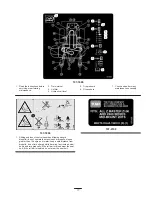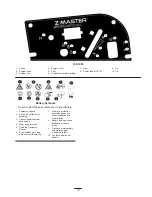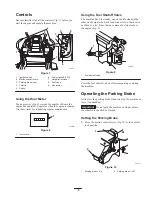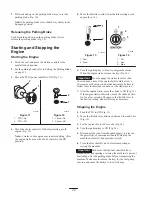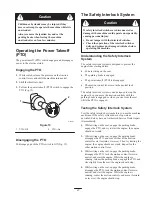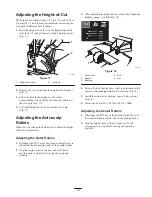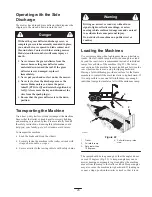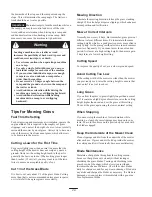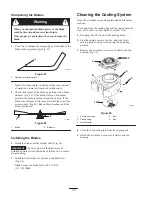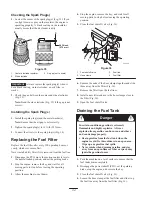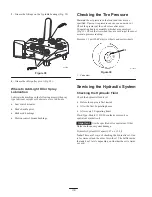
25
Operating with the Side
Discharge
The mower has a hinged grass deflector that disperses the
clippings to the side and down toward the turf.
Danger
Without the grass deflector, discharge cover, or
complete grass catcher assembly mounted in place,
you and others are exposed to blade contact and
thrown debris. Contact with the rotating mower
blade(s) and thrown debris will cause injury or
death.
•
Never remove the grass deflector from the
mower because the grass deflector routes
material down toward the turf. If the grass
deflector is ever damaged, replace it
immediately.
•
Never put your hands or feet under the mower.
•
Never try to clear the discharge area or the
mower blades unless you move the power
takeoff (PTO) to Off and rotate the ignition key
to Off. Also remove the key and disconnect the
wire from the spark plug(s).
•
Ensure that the grass deflector is in the down
position.
Transporting the Machine
Use a heavy-duty trailer or truck to transport the machine.
Ensure that the trailer or truck has all necessary lighting
and marking as required by law. Please carefully read all
the safety instructions. Knowing this information could
help you, your family, pets, or bystanders avoid injury.
To transport the machine:
•
Lock the brake and block the wheels.
•
Securely fasten the machine to the trailer or truck with
straps, chains, cable, or ropes.
•
Secure a trailer to the towing vehicle with safety chains.
Driving on a street or roadway without turn
signals, lights, reflective markings, or a slow
moving vehicle emblem is dangerous and can lead
to accidents that cause personal injury.
Do not drive the machine on a public street or
roadway.
Warning
Loading the Machines
Use extreme caution when loading machines on trailers or
trucks. One full-width ramp that is wide enough to extend
beyond the rear tires is recommended instead of individual
ramps for each side of the machine (Fig. 22). The lower
rear section of the machine frame extends back between the
rear wheels and serves as a stop for tipping backward.
Having a full-width ramp provides a surface for the frame
members to contact if the machine starts to tip backward. If
it is not possible to use one full width ramp, use enough
individual ramps to simulate a full width continuous ramp.
m–6841
1
4
1
2
3
Figure 22
1.
Trailer
2.
Full width ramp
3.
Not greater than
15 degrees
4.
Full width ramp—side
view
The ramp should be long enough so that the angles do not
exceed 15 degrees (Fig. 22). A steeper angle may cause
mower housing components to get caught as the machine
moves from the ramp to the trailer or truck. Steeper angles
may also cause the machine to tip backward. If loading on
or near a slope, position the trailer or truck so that it is on

